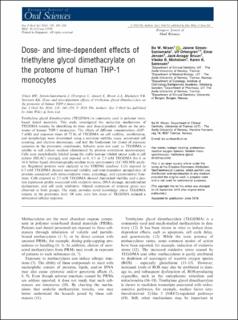| dc.contributor.author | Nilsen, Bo Wold | |
| dc.contributor.author | Simon-Santamaria, Jaione | |
| dc.contributor.author | Ørtengren, Ulf Thore | |
| dc.contributor.author | Jensen, Einar | |
| dc.contributor.author | Bruun, Jack-Ansgar | |
| dc.contributor.author | Michelsen, Vibeke Barman | |
| dc.contributor.author | Sørensen, Karen Kristine | |
| dc.date.accessioned | 2022-04-27T13:27:00Z | |
| dc.date.available | 2022-04-27T13:27:00Z | |
| dc.date.created | 2018-09-27T21:20:23Z | |
| dc.date.issued | 2018 | |
| dc.identifier.issn | 0909-8836 | |
| dc.identifier.uri | https://hdl.handle.net/11250/2993072 | |
| dc.description.abstract | Triethylene glycol dimethacrylate (TEGDMA) is commonly used in polymer resin-based dental materials. This study investigated the molecular mechanisms of TEGDMA toxicity by identifying its time- and dose-dependent effects on the proteome of human THP-1 monocytes. The effects of different concentrations (0.07–5 mM) and exposure times (0–72 h) of TEGDMA on cell viability, proliferation, and morphology were determined using a real-time viability assay, automated cell counting, and electron microscopy, and laid the fundament for choice of exposure scenarios in the proteomic experiments. Solvents were not used, as TEGDMA is soluble in cell culture medium (determined by photon correlation spectroscopy). Cells were metabolically labeled [using the stable isotope labeled amino acids in cell culture (SILAC) strategy], and exposed to 0, 0.3 or 2.5 mM TEGDMA for 6 or 16 h before liquid chromatography-tandem mass spectrometry (LC-MS/MS) analyses. Regulated proteins were analyzed in the STRING database. Cells exposed to 0.3 mM TEGDMA showed increased viability and time-dependent upregulation of proteins associated with stress/oxidative stress, autophagy, and cytoprotective functions. Cells exposed to 2.5 mM TEGDMA showed diminished viability and a protein expression profile associated with oxidative stress, DNA damage, mitochondrial dysfunction, and cell cycle inhibition. Altered expression of immune genes was observed in both groups. The study provides novel knowledge about TEGDMA toxicity at the proteomic level. Of note, even low doses of TEGDMA induced a substantial cellular response. | en_US |
| dc.language.iso | eng | en_US |
| dc.publisher | Wiley | en_US |
| dc.rights | Navngivelse-Ikkekommersiell 4.0 Internasjonal | * |
| dc.rights.uri | http://creativecommons.org/licenses/by-nc/4.0/deed.no | * |
| dc.title | Dose- and time-dependent effects of triethylene glycol dimethacrylate on the proteome of human THP-1 monocytes | en_US |
| dc.type | Journal article | en_US |
| dc.type | Peer reviewed | en_US |
| dc.description.version | publishedVersion | en_US |
| dc.rights.holder | Copyright 2018 The Author(s) | en_US |
| cristin.ispublished | true | |
| cristin.fulltext | original | |
| cristin.qualitycode | 2 | |
| dc.identifier.doi | 10.1111/eos.12559 | |
| dc.identifier.cristin | 1615320 | |
| dc.source.journal | European Journal of Oral Sciences | en_US |
| dc.source.pagenumber | 345-358 | en_US |
| dc.identifier.citation | European Journal of Oral Sciences. 2018, 126 (5), 345-358. | en_US |
| dc.source.volume | 126 | en_US |
| dc.source.issue | 5 | en_US |

